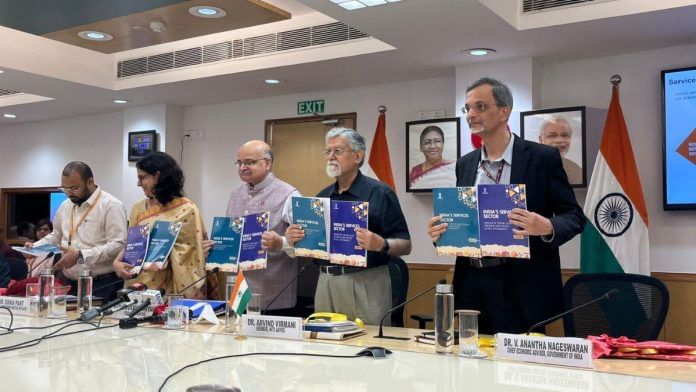New Delhi: In India, women engaged in the services sector in rural areas face high wage disparity—earning less than half of what men earn. The disparity exists even in urban areas, where women earn 84% of what men earn, according to a NITI Aayog report, India’s Services Sector: Insights from Employment Trends and State Level Dynamics released Tuesday.
According to the report, wage gap persists across most sub-sectors, shaped by occupational segregation, limited access to high-paying positions, and skill mismatch.
“Expanding female participation is, therefore, necessary but not sufficient; without addressing pay equity and enabling women to move into high-value roles, services risk reproducing wider labour market inequalities,” the report states.
The report was launched Tuesday by B.V.R. Subrahmanyam, CEO of NITI Aayog in the presence of Arvind Virmani, member NITI Aayog and V. Anantha Nageswaran, chief economic adviser to the government.
Citing the importance of the services sector in terms of job creation, Subrahmanyam said, “This is the most dynamic sector at the moment in terms of job creation. If India is to become a developed nation, which is the goal of our Prime Minister, I think services have to play an equal, if not the most important role in driving our growth.”
The federal think tank report states that the service sector employs nearly 188 million people (30 percent of the total workforce) across India, behind agriculture which employs 292 million.
The report cites that traditional services sectors that include trade and repair, transport, education, travel and professional services account for over 80 percent (155 million) of the employment. Meanwhile only 13 percent (25 million) are engaged in modern services related to technology, healthcare and finance.
“These sub-sectors (modern services) represent India’s most dynamic areas of growth, characterised by higher productivity, better wages, and stronger links to global value chains. Yet, even combined, they employ fewer than 25 million workers, far smaller than trade alone,” report states.
These modern services have high employment elasticity, meaning that employment grows in proportion to or faster than the economic output.
Services that have high elasticity are computer & information services (0.79), health (0.74), and financial services (0.74), whereas sectors like transport (0.53) and trade and repair (0.39) with lower elasticity absorb labour at scale but have low productivity.
The report states, “India’s services employment is still dominated by low-value, traditional activities, while high-value services, though fast-growing, have not yet scaled enough to transform the labour market.”
The think tank recommends policy support to accelerate the transition of workers from traditional to modern sub-sectors through skilling, digital infrastructure, and service cluster development.
According to the report, while India has added nearly 40 million jobs in the service sector over the last six years to reach 188 million in 2023-24 (30 percent of total workforce), it is still lagging behind the global average of around 50 percent in the service sector.
Citing World Bank data, the report states that between 1992 and 2022, the global share of workers employed in services rose from 35.5 percent to 49.8 percent, while in India’s case, transition has been slower, with services’ share of employment rising from 22.1 percent in 1992 to 31 percent in 2022.
Gaps and disparities in the services sector
The federal think tank report highlights the gaps in India’s service sector on parameters related to location, gender and employment type.
The services sector accounts for 60.8 percent of the jobs in urban areas, while it is only 18.9 percent in rural areas. The share of services in rural employment declined from 19.9 percent to 18.9 percent between 2017-18 and 2023-24.
The report states, “Rural services are confined to trade, transport and education, while urban services cover a more diverse, higher-value set of activities such as finance, information technology and health.”
The report also highlights a gap of 14.8 percentage points among the male and female workforce in the service sector.
“Between 2017–18 and 2023–24, male participation in services increased from 32.8 percent to 34.9 percent, while female participation declined from 25.2 percent to 20.1 percent,” the report said.
According to the report, the gender gap in the service sector is primarily limited to rural areas, where the female workforce (76.9 percent) is overwhelmingly engaged in the agriculture sector. Nearly 24 percent of rural men are engaged in the service sector in comparison to only 10.5 percent women.
However, in urban areas, both men (61 percent) and women (60 percent) have equal participation in the services sector.
According to B.V.R. Subrahmanyam, it is important to bridge gaps in service sector employment that vary across different parameters. He cites that states can plan an important role by coming up with state-level strategies.
“We need to have state level strategies related to education, skilling and basic infrastructure that is needed in the services sector,” said Subrahmanyam.
(Edited by Viny Mishra)
Also read: India needs a National Jobs Mission, not just skilling






